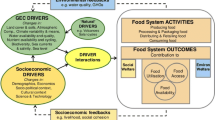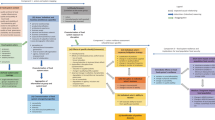Abstract
The purpose of applying social-ecological resilience thinking to food systems is twofold: first, to define those factors that help achieve a state in which food security for all and at all scales is possible and second, to provide insights into how to maintain the system in this desirable regime. However, the resilience of food systems is distinct from the broader conceptualizations of resilience in social-ecological systems because of the fundamentally normative nature of food systems: humans need food to survive, and thus, system stability is typically a primary policy objective for food system management. However, society also needs food systems that can intensify sustainably, i.e., feed everybody equitably, provide livelihoods, and avoid environmental degradation while responding flexibly to shocks and uncertainty. Today’s failure in meeting food security objectives can be interpreted as the lack of current governance arrangements to consider the full and differential dimensions of food system functions—economic, ecological, and social—at appropriate scales: in other words, the multifunctionality of food. We focus on functional and response diversity as two key attributes of resilient, multifunctional food systems, respectively, the number of different functional groups and the diversity of types of responses to disturbances within a functional group. Achieving food security will require functional redundancy and enhanced response diversity, creating multiple avenues to fulfill all food system objectives. We use the 2013–2015 drought in California to unpack the potential differences between managing for a single function—economic profit—and multiple functions. Our analysis emphasizes how the evolution of the Californian food system has reduced functional and response diversity and created vulnerabilities. Managing for the resilience of food systems will require a shift in priorities from profit maximization to the management for all functions that create full food security at multiple scales.

Similar content being viewed by others
Notes
A social-ecological system is an integrated system in which humans are part of nature and therefore cultural, political, social, economic, ecological, and technological components interact (Berkes and Folke 1998).
References
Adger WN, Eakin H, Winkels A (2009) Nested and teleconnected vulnerabilities to environmental change. Front Ecol Environ 7(3):150–157
Alexander K (2014) California Drought: Jobs, money dry up in farm towns. SFGate. San Francisco. Retrieved June 24th 2014, from http://www.sfgate.com/news/article/California-drought-Jobs-money-dry-up-in-farm-5431129.php#photo-6226893
Allison HE, Hobbs RJ (2004) Resilience, adaptive capacity, and the “Lock-in Trap” of the western Australian agricultural region. Ecol Soc 9(1):Art. 3
Altieri MA (1989) Agroecology: a new research and development paradigm for world agriculture. Agric Ecosyst Environ 27(1-4):37–46
Berkes F, Folke C (1998) Linking social and ecological systems. Cambridge University Press, Cambridge
Berkes F, Hughes TP, Steneck RS, Wilson JA, Bellwood DR, Crona B, Worm B (2006) Ecology. Globalization, roving bandits, and marine resources. Science (New York, NY) 311(5767):1557–8
Bruno C (2014) Assessing California’s economic growth by region. Advancing a free society. Hoover Institution Stanford University. Retrieved April 29th 2014, from http://www.advancingafreesociety.org/eureka/assessing-californias-economic-growth-by-region/
Burger J (2014) Food giveaway aims to combat drought-driven hunger. Bakersfield Californian. Bakersfield. Retrieved June 24th 2014, from http://www.bakersfieldcalifornian.com/local/x1484118372/Food-giveaway-aims-to-combat-drought-driven-hunger
Carpenter S, Walker B, Anderies JM, Abel N (2001) From metaphor to measurement: resilience of what to what? Ecosystems 4(8):765–781
Cash S, Zilberman D (2003) Environmental issues in California agriculture. In: Siebert J (ed) California agriculture dimensions and issues. Giannini Foundation of Agricultural Economics, University of California, Davis
CDFA (2014a) California agricultural production statistics. California Department of Food and Agriculture. Retrieved April 22nd 2014, from http://www.cdfa.ca.gov/statistics/
CDFA (2014b) California agricultural statistics review 2013-2014. California Department of Food and Agriculture, Sacremento
CFPA (2010) San Joaquin County nutrition and food insecurity profile. Retrieved June 22nd 2014, from http://cfpa.net/GeneralNutrition/CFPAPublications/CountyProfiles/2010/CountyProfile-SanJoaquin-2010.pdf
Cinner JE, McClanahan TR, Daw TM, Graham NAJ, Maina J, Wilson SK, Hughes TP (2009) Linking social and ecological systems to sustain coral reef fisheries. Curr Biol 19(3):206–12
Clapp J (2011) Food. Polity, Cambridge
Coleman-Jensen A, Nord M, Singh A (2013) Household food security in the United States in 2012. ERS USDA, Washington DC
Cowan T (2005) California’s San Joaquin Valley: a region in transition. Congressional Research Service, Washington DC
Davis M (2001) Late Victorian holocausts: El Niño famines and the making of the third world. Verso, New York
DeFries R, Asner GP, Foley J (2006) A glimpse out the window: landscapes, livelihoods, and the environment. Environ: Sci Policy Sustain Deve 48(8):22–36
Duke SO (2005) Taking stock of herbicide-resistant crops ten years after introduction. Pest Manag Sci 61(3):211–8
Eakin H (2010) What is Vulnerable? In: Ingram J, Ericksen PJ, Liverman D (eds) Food security and global environmental change. Earthscan, London
Eakin H, Bohle H-G, Izac A-M, Reenberg A, Gregory P, Pereira L (2010) Food, violence and human rights. In: Ingram J, Ericksen PJ, Liverman D (eds) Food security and global environmental change. Earthscan, London
Eakin H, Tompkins E, Nelson DR, Anderies JM (2009) Hidden costs and disparate uncertainties: trade-offs involved in approaches to climate policy. In: Adger WN, Lorenzoni I, O’Brien K (eds) Adapting to climate change: thresholds, values, governance. Cambridge University Press, Cambridge
Elmqvist T, Folke C, Nyström M, Peterson G, Bengtsson J, Walker B, Norberg J (2003) Response diversity, ecosystem change, and resilience. Front Ecol Environ 1(9):488–494
Ericksen PJ (2008) Conceptualizing food systems for global environmental change research. Glob Environ Chang 18(1):234–245
FAO (2002) The state of food insecurity in the world 2001. Food and Agriculture Organisation of the United Nations, Rome
FAO (2014) FAO’s resilience index measurement and analysis (RIMA) model. Improved global governance for hunger reduction. Food and Agriculture Organisation of the United Nations, Rome
FAO, IFAD & WFP (2013) The state of food insecurity in the world 2013. The multiple dimensions of food security. Food and Agriculture Organisation of the United Nations, Rome
Fernandez-Cornejo J, Wechsler S, Livingstone M & Mitchell L (2014) Genetically engineered crops in the United States, ERR-162 U.S. Department of Agriculture, Economic Research Service, February 2014
Fimrite P (2014) California drought: how water crisis is worse for almonds. SFGate. San Francisco. Retrieved 22nd April 2014, from http://www.sfgate.com/science/article/California-drought-How-water-crisis-is-worse-for-5341382.php#page-2
Folke C, Carpenter S, Walker B, Scheffer M, Elmqvist T, Gunderson L, Holling CS (2004) Regime shifts, resilience, and biodiversity in ecosystem management. Annu Rev Ecol Evol Syst 35(1):557–581
Folke C, Colding J, Berkes F (2003) Building resilience and adaptive capacity in social-ecological systems. In: Berkes F, Colding J, Folke C (eds) Navigating Social-Ecological Systems. Cambridge University Press, Cambridge, pp 352–387
Fraser EDG, Mabee W, Figge F (2005) A framework for assessing the vulnerability of food systems to future shocks. Futures 37(6):465–479
Holling CS (1973) Resilience and stability of ecological systems. Annu Rev Ecol Syst 4:1–23
Howitt R, Medellin-Azuara J, MacEwan D, Lund J, Sumner D (2014) Economic analysis of the 2014 drought for California agriculture. University of California Davis Center for Watershed Sciences, Davis, CA
IPCC (2014) Climate change 2014: impacts, adaptation, and vulnerability. In: Barros V, Field C (eds) Contribution of working group II to the fifth assessment report of the intergovernmental panel on climate change. Cambridge University Press, Cambridge
Keppen D, Dutcher P (2015) The 2014 drought and water management policy impacts on California’s Central Valley food production. J Environ Sci Stud. doi:10.1007/s13412-015-0283-3
Klonsky K (2010) A look at California’s organic agriculture production. Davis, CA. Retreived June 24th 2014, from: http://giannini.ucop.edu/media/are-update/files/articles/v14n2_3.pdf
Lang T (2003) Food industrialisation and food power: implications for food governance. Dev Policy Rev 21(5-6):555–568
Lerner AM, Eakin H (2011) An obsolete dichotomy? Rethinking the rural-urban interface in terms of food security and production in the global south. Geogr J 177(4):311–320
Levin SA, Barrett S, Aniyar S, Baumol W, Bliss C, Bolin B, Sheshinski E (1998) Resilience in natural and socioeconomic systems. Environ Dev Econ 3(02):221–262
Marsden T, Banks J, Bristow G (2000) Food supply chain approaches: exploring their role in rural development. Sociol Rural 40(4):424–438
May RM (1973) Stability and complexity in model ecosystems. Princeton Univ. Press, Princeton
McMichael P (2006) New directions in the sociology of global development. Research in rural sociology and development. Bingley, Emerald
Mekonnen MM, Hoekstra AY (2010) The green, blue and grey water footprint of crops and derived crop products, Value of Water Research Report Series No. 47. UNESCO-IHE Institute for Water Education, Delft
Morales H (2002) Pest management in traditional tropical agroecosystems: lessons for pest prevention research and extension. Integr Pest Manag Rev 7(3):145–163
National Research Council (2012) National summit on strategies to manage herbicide-resistant weeds: proceedings of a symposium. The National Academies Press, Washington DC
Office of Governor Brown (2014) Governor Brown declares drought state of emergency. California Drought. Retrieved April 22nd 2014, from http://gov.ca.gov/news.php?id=18368
Paggi M (2011) California agriculture’s role in the economy and water use characteristics. The Center for Agricultural Business, California State University, Fresno, CA
Powles SB (2008) Evolved glyphosate-resistant weeds around the world: lessons to be learnt. Pest Manag Sci 64(4):360–5
Richards T (2014) Which foods may cost you more due to California drought. ASU News. Retrieved April 22nd 2014, from https://asunews.asu.edu/20140416-business-drought-grocery-prices-richards
Rosegrant MW, Ringler C, Zhu T (2009) Water for agriculture: maintaining food security under growing scarcity. Annu Rev Environ Resour 34:205–222
Shear-McMann K (2000) The diversity-stability debate. Nature 405:228–233
Sneed M, Brandt J, Solt M (2013) Land subsidence along the Delta-Mendota Canal in the northern part of the San Joaquin Valley, California, 2003–10. USGS, Washington DC
State of California (2014) Stockton Metropolitan Statistical Area. Stockton, CA. Retrieved June 24th 2014, from http://www.calmis.ca.gov/file/lfmonth/stoc$pds.pdf
Sundkvist Å, Milestad R, Jansson A (2005) On the importance of tightening feedback loops for sustainable development of food systems. Food Policy 30(2):224–239
Thompson J, Scoones I (2009) Addressing the dynamics of agri-food systems: an emerging agenda for social science research. Environ Sci Pol 12(4):386–397
Tilman D (1996) Biodiversity: population versus ecosystem stability. Ecology 77:350–363
USDA (2013) Adoption of genetically engineered crops in the U.S. Economic Research Service, United States Department of Agriculture. Retrieved April 23rd 2014, from http://www.ers.usda.gov/data-products/adoption-of-genetically-engineered-crops-in-the-us/recent-trends-in-ge-adoption.aspx#.U1cObfldV8F
USDA (2014a) California drought 2014: livestock, dairy, and poultry sectors. Retrieved June 25th 2014, from http://www.ers.usda.gov/topics/in-the-news/california-drought-2014-farm-and-food-impacts/#.VA-gGvmwLYg
USDA (2014b) US drought and your food costs. Retrieved June 25th 2014, from http://www.usda.gov/documents/drought-infographic-food-costs.pdf
Walker BH, Gunderson LH, Kinzig AP, Folke C, Carpenter SR, Schultz L (2006) A handful of heuristics and some propositions for understanding resilience in social-ecological systems. In: Walker BH, Anderies JM, Kinzig AP, Ryan P (eds) Exploring resilience in social-ecological systems. CSIRO, Collingwood, pp 5–22
Walker B, Kinzig A, Langridge J (1999) Plant attribute diversity, resilience, and ecosystem function: the nature and significance of dominant and minor species. Ecosystems 2(2):95–113
Westley F, Carpenter SR, Brock WA, Holling CS, Gunderson LH (2002) Why systems of people and nature are not just social and ecological systems. In: Gunderson LH, Holling CS (eds) Panarchy: understanding transformations in human and natural systems. Island Press, Washington DC, pp 103–119
Conflict of interest
The authors declare that they have no competing interests.
Author information
Authors and Affiliations
Corresponding author
Rights and permissions
About this article
Cite this article
Hodbod, J., Eakin, H. Adapting a social-ecological resilience framework for food systems. J Environ Stud Sci 5, 474–484 (2015). https://doi.org/10.1007/s13412-015-0280-6
Published:
Issue Date:
DOI: https://doi.org/10.1007/s13412-015-0280-6




